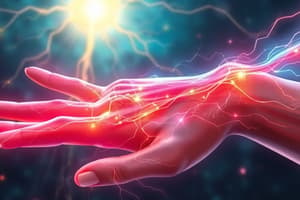Podcast
Questions and Answers
In high median nerve palsy, which digits are MOST affected?
In high median nerve palsy, which digits are MOST affected?
- Digits 4 and 5
- Digits 2 and 3 (correct)
- Digits 3 and 4
- Digits 1 and 2
Which presentation is characteristic of a high median nerve palsy when a patient attempts to make a fist (traditional presentation)?
Which presentation is characteristic of a high median nerve palsy when a patient attempts to make a fist (traditional presentation)?
- MCP and IP joints of digits 2-3 flexed
- MCP joints of digits 2-3 hyperextended, IP joints flexion absent (correct)
- MCP joints of digits 2-3 flexed, IP joints extended
- MCP joints of digits 2-3 extended, IP joints flexed
If a patient presents with thenar wasting and impaired thumb abduction, which nerve is MOST likely affected?
If a patient presents with thenar wasting and impaired thumb abduction, which nerve is MOST likely affected?
- Musculocutaneous nerve
- Median nerve (correct)
- Radial nerve
- Ulnar nerve
What is the typical hand posture at REST in someone with a high median nerve palsy?
What is the typical hand posture at REST in someone with a high median nerve palsy?
Which muscles of the hand are typically paralyzed in high median nerve palsy (select all that apply)?
Which muscles of the hand are typically paralyzed in high median nerve palsy (select all that apply)?
Flashcards
Median nerve
Median nerve
Nerve involved in high median nerve palsy affecting digits 2-3.
Digits affected
Digits affected
Digits 2 and 3 are most impacted by high median nerve palsy.
Hand of Benediction
Hand of Benediction
Presentation where fingers 2-3 can't flex when making a fist.
Thenar muscles
Thenar muscles
Signup and view all the flashcards
Clinical signs
Clinical signs
Signup and view all the flashcards
Study Notes
High Median Nerve Palsy ("Hand of Benediction")
- Nerve Involved: Median nerve
- Site of injury: High or proximal to the elbow
- Digits affected: Digits 2 and 3 are most commonly affected.
- Muscles Paralyzed:
- Lateral half of Flexor Digitorum Profundus (FDP)
- Lumbricals (digits 2-3)
- Thenar muscles
- Presentation with open palm at rest: Normal
- Presentation when making a fist (traditional)
- MCP (metacarpophalangeal) joints 2-3 are hyperextended
- IP (interphalangeal) joints 2-3 have no flexion
- MCP and IP joints 4-5 have full flexion
- Presentation when making a fist (revised)
- MCP joints 2-3 are flexed
- PIP (proximal interphalangeal) and DIP (distal interphalangeal) joints of the 2nd digit are extended
- DIP joint of the 3rd digit is flexed
- MCP and IP joints 4-5 have full flexion
- Additional clinical signs:
- Thenar muscle atrophy or flattening
- Loss of thumb opposition
- Impaired thumb abduction
- Impaired wrist pronation and flexion
Studying That Suits You
Use AI to generate personalized quizzes and flashcards to suit your learning preferences.




